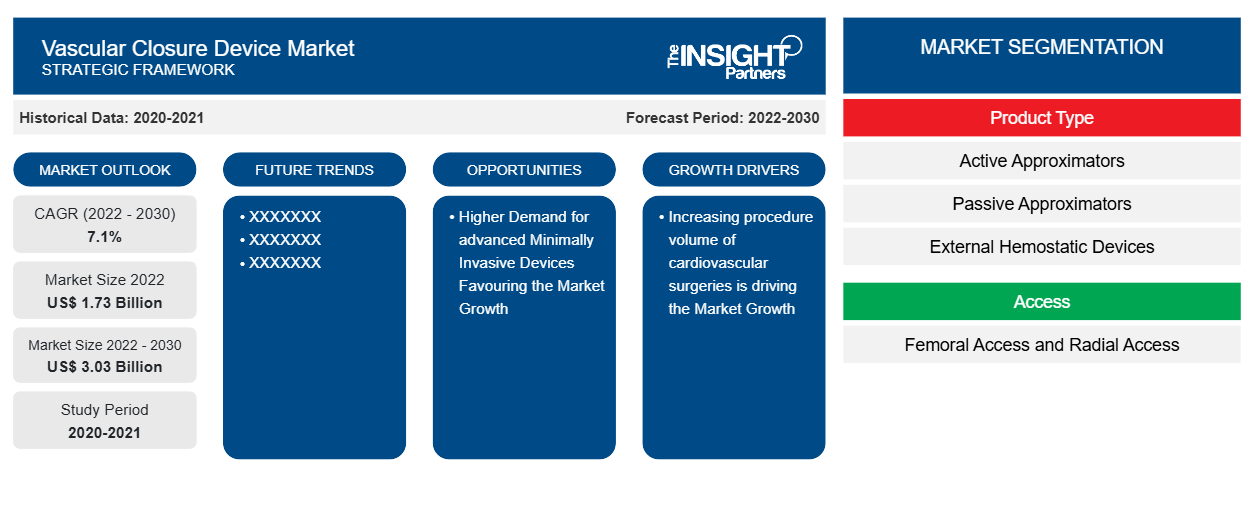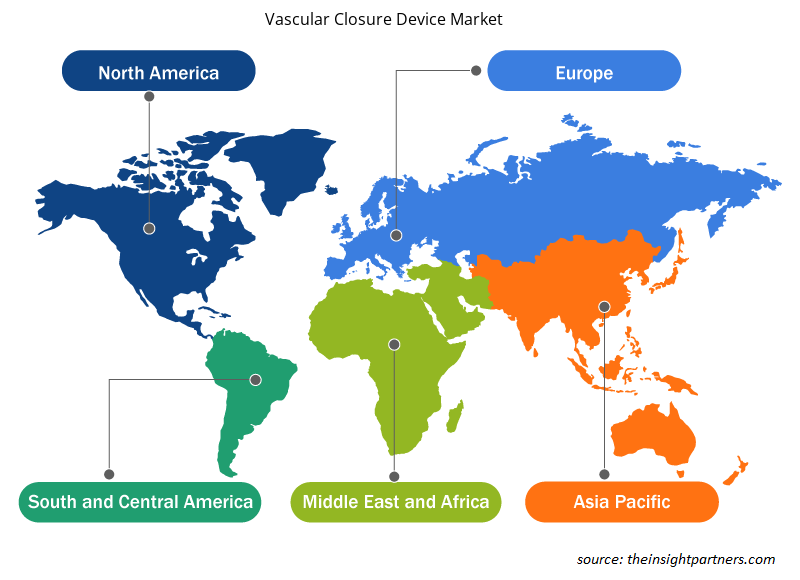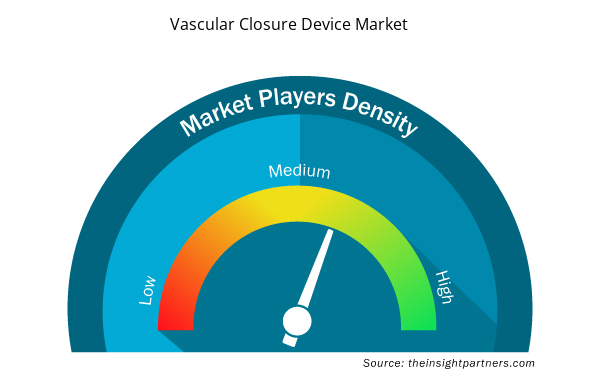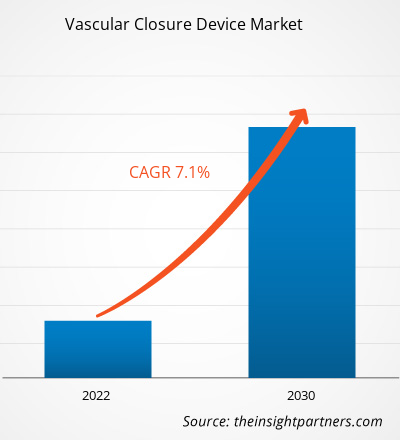The vascular closure device market size is projected to reach US$ 3.03 billion by 2030 from US$ 1.73 billion in 2022. The market is expected to register a CAGR of 7.1% in 2022–2030. The global market's growth is primarily attributed to the higher prevalence of cardiovascular diseases and the burgeoning demand for minimally invasive devices. However, the risk of infection related to vascular closure devices may hinder the market growth.
Vascular Closure Device Market Analysis
Vascular closure devices (VCDs) are medical devices that are utilized following endovascular surgery or other cardiovascular procedures that need catheterization to achieve hemostasis of the small hole in the artery. Catheterization is necessary for a variety of cardiovascular operations, including interventional procedures like coronary thrombectomy, angioplasty, and stent insertion that aid in the diagnosis of damaged blood arteries. One of the leading causes of death worldwide is cardiovascular illnesses, which include acute myocardial infarction, angina pectoris, and atherosclerosis. Therefore, the market expansion for vascular closure devices is driven by the higher demand for minimally invasive devices.
Vascular Closure Device Market Overview
Cardiovascular diseases such as atherosclerosis, angina pectoris, and acute myocardial infarction are the major causes of mortality in the world. As per data provided by the World Health Organization (WHO), cardiovascular diseases cause nearly 17.9 million deaths every year, which makes it a leading cause of mortality among all noncommunicable diseases, followed by cancer, chronic respiratory diseases, and diabetes (including deaths associated with renal disorders). According to the World Heart Federation, high cholesterol causes 4.4 million deaths yearly, and ∼24% of cardiovascular-related deaths are associated with high low-density lipoprotein (LDL) levels. According to a study published in January 2023 by NCBI, in the US, the number of people aged 50 years and older is likely to reach 221.13 million by 2050 from 137.25 million in 2020. Among people from this age group, the number of people suffering from at least one chronic disease is projected to rise by 99.5%, reaching 142.66 million by 2050 from 71.52 million in 2020. Moreover, ~14 million people aged 50 and above are likely to have comorbidities in 2050.
Vascular closure devices (VCDs) offer a new way to enhance patients’ comfort and ambulation after invasive cardiovascular treatments via femoral arterial access. Vascular closure devices are used in different therapeutic approaches to provide easy, quick, and reliable hemostasis. In the US, femoral arterial access is the most often used vascular access technique for percutaneous coronary intervention (PCI) and coronary angiography. Nevertheless, there has been an increase in traction toward cardiac catheterization and percutaneous coronary intervention (PCI) via radial access in recent years. Several femoral artery closure devices have been developed to shorten vascular closure times, with variable rates of vascular complications observed in clinical trials. Vascular closure devices (VCDs) have emerged as an effective alternative to traditional mechanical compression procedures performed after cardiac catheterization. VCDs reduce the time of hospital stays, speed up patient mobilization, and shorten the time needed to achieve hemostasis. Thus, the vascular closure device market is growing notably with the increasing prevalence of cardiovascular diseases.
Customize This Report To Suit Your Requirement
You will get customization on any report - free of charge - including parts of this report, or country-level analysis, Excel Data pack, as well as avail great offers and discounts for start-ups & universities
Vascular Closure Device Market: Strategic Insights

- Get Top Key Market Trends of this report.This FREE sample will include data analysis, ranging from market trends to estimates and forecasts.
Customize This Report To Suit Your Requirement
You will get customization on any report - free of charge - including parts of this report, or country-level analysis, Excel Data pack, as well as avail great offers and discounts for start-ups & universities
Vascular Closure Device Market: Strategic Insights

- Get Top Key Market Trends of this report.This FREE sample will include data analysis, ranging from market trends to estimates and forecasts.
Vascular Closure Device Market Drivers and Opportunities
Higher Demand for Minimally Invasive Devices Favors Market
Improvements in medical science and technologies have given way to minimally invasive devices, which can aid in the replacement of traditional painful surgical methods by minimally invasive or non-invasive methods. Minimally invasive techniques have gained popularity in surgical fields such as cardiac surgery. Many of these procedures are performed using femoral cannulation for extracorporeal circulation. Vascular closure devices have gained popularity as they reduce invasiveness and supersede surgical cut-downs to cannulate the femoral artery. Vascular closure devices are mainly used in transcatheter and endovascular interventions to enable wound healing and reduce procedure time.
Angiography is one of the common procedures performed in a wide variety of specialties, including vascular surgery, interventional radiology, and diagnostic and interventional cardiology. Vascular closure devices are useful in the settings of a large body habitus, as well as anticoagulation and antiplatelet therapies. They are also used in cases where extended bed rest may not be desirable (such as a patient with extensive pressure ulcers). A vascular closure device with resorbable collagen material, which eliminates the use of suture materials, has been introduced for transfemoral transcatheter aortic valve implantation (TAVI). For instance, the MANTA device by Teleflex Medical Inc. is adequate for the closure of arterial access sites of up to 25 Fr. Safety and efficacy of the system were demonstrated in a real-world TAVI patient cohort. Thus, the increasing demand for minimally invasive devices drives the vascular closure devices market growth
Untapped Potential of Emerging Economies – An Opportunity in Vascular Closure Device Market
Vascular closure devices market players should anticipate significant growth opportunities in emerging nations like India, China, Argentina, Brazil, UAE, and South Africa because of factors like growing disposable incomes, an aging patient population, increased R&D, improved healthcare infrastructure, rising awareness of CVD, and relatively lax guidelines in comparison to developed nations. Russia, Brazil, China, India, and South Africa together accounted for one-third of all global health spending as of 2022, according to the World Economic Forum. The World Bank reports that from 2018 to 2019, health spending grew by 3.01% in India and 5.35% in China. Also, there has been an upsurge in heart failure cases over the past decade in emerging markets, which has resulted in a large number of cardiovascular disease-related deaths. As per the India Brand Equity Foundation, hospitals contribute to ~70% of the revenue of the healthcare sector in India. In China, the number of private hospitals reached up to 36,000 in 2022. Moreover, the private hospitals account for ~57% of total number of hospitals in the country. The number of surgical centers and hospitals in developing markets is estimated to grow due to rising healthcare spending and a surge in the target patient population. Thus, the development of healthcare facilities in developing economies, along with a surge in the number of hospitals, would propel the awareness and adoption of vascular closure devices in emerging economies. Further, vast competition in developed or matured markets encourages vascular closure device manufacturers to focus on developing markets, which is likely to offer growth opportunities for vascular closure device providers to attain a significant position in the market.
Vascular Closure Device Market Report Segmentation Analysis
Key segments that contributed to the derivation of the vascular closure device market analysis are product type, access, procedure, and end users.
- Based on product type, the vascular closure device market is divided into active approximators, passive approximators, and external hemostatics. The passive approximators device segment held a higher market share in 2022.
- Based on access, the market is segmented into Femoral Access and Radial Access.
- In terms of procedure, the market is segmented into interventional cardiology, interventional radiology, and endovascular surgical.
- In terms of end users, the market is segmented into Hospitals, ABSc, and Others.
Vascular Closure Device Market Share Analysis by Geography
The geographic scope of the vascular closure device market report is mainly divided into five regions: North America, Asia Pacific, Europe, Middle East & Africa, and South America/South & Central America.
In North America, the vascular closure device market is currently experiencing exponential growth during the forecast years. The North America vascular closure devices market is segmented into the US, Canada, and Mexico; the US held the largest share of the market in 2022. The US is a hub for medical innovations and technological advancements in healthcare. Continuous advancements in technologies associated with minimally invasive procedures, improvements in closure device technologies, and the introduction of novel closure devices contribute to the growth of the vascular closure devices market in the US. For instance, in March 2023, Haemonetics Corporation (US) invested ~US$ 31.72 million (EUR 30 million) in Vivasure Medical Limited. In March 2023, Vivasure Medical announced FDA IDE approval to Initiate a US Pivotal Study evaluating the safety and effectiveness of the Vivasure PerQseal Closure Device System. In 2021, VASCADE MVP was the first and only FDA-approved vascular closure device indicated for use following atrial fibrillation (AF) ablation to allow same-day discharge.
Vascular Closure Device Market Regional Insights
The regional trends and factors influencing the Vascular Closure Device Market throughout the forecast period have been thoroughly explained by the analysts at Insight Partners. This section also discusses Vascular Closure Device Market segments and geography across North America, Europe, Asia Pacific, Middle East and Africa, and South and Central America.

- Get the Regional Specific Data for Vascular Closure Device Market
Vascular Closure Device Market Report Scope
| Report Attribute | Details |
|---|---|
| Market size in 2022 | US$ 1.73 Billion |
| Market Size by 2030 | US$ 3.03 Billion |
| Global CAGR (2022 - 2030) | 7.1% |
| Historical Data | 2020-2021 |
| Forecast period | 2022-2030 |
| Segments Covered |
By Product Type
|
| Regions and Countries Covered | North America
|
| Market leaders and key company profiles |
Vascular Closure Device Market Players Density: Understanding Its Impact on Business Dynamics
The Vascular Closure Device Market market is growing rapidly, driven by increasing end-user demand due to factors such as evolving consumer preferences, technological advancements, and greater awareness of the product's benefits. As demand rises, businesses are expanding their offerings, innovating to meet consumer needs, and capitalizing on emerging trends, which further fuels market growth.
Market players density refers to the distribution of firms or companies operating within a particular market or industry. It indicates how many competitors (market players) are present in a given market space relative to its size or total market value.
Major Companies operating in the Vascular Closure Device Market are:
- Cordis Corp.
- Transluminal Technologies LLC
- Vasorum Ltd
- Haemonetics Corp.
- Abbott Laboratories
- Becton Dickinson and Co
Disclaimer: The companies listed above are not ranked in any particular order.

- Get the Vascular Closure Device Market top key players overview
Vascular Closure Device Market News and Recent Developments
The vascular closure device market is evaluated by gathering qualitative and quantitative data post primary and secondary research, which includes important corporate publications, association data, and databases. The following is a list of developments in the market for innovations, business expansion, and strategies:
- In May 2022, Teleflex Inc., a global provider of medical technologies, announced that it received Health Canada approval for the MANTA Vascular Closure Device – the first commercially available biomechanical vascular closure device designed specifically for large bore femoral arterial access site closure. This approval marks an important milestone in the regulatory plan to expand the availability of the MANTA Device globally and provide Canadian clinicians access to another uniquely designed device from Teleflex. (Source: Teleflex Inc. company website)
Vascular Closure Device Market Report Coverage and Deliverables
The “Vascular Closure Device Market Size and Forecast (2020–2030)” report provides a detailed analysis of the market covering the following areas:
- Vascular Closure Device Market size and forecast at global, regional, and country levels for all the key market segments covered under the scope
- Market dynamics such as drivers, restraints, and key opportunities
- Vascular Closure Device Market trends
- Detailed PEST/Porter’s Five Forces and SWOT analysis
- Vascular Closure Device market analysis covering key market trends, global and regional framework, major players, regulations, and recent market developments
- Vascular Closure Device Industry landscape and competition analysis covering market concentration, heat map analysis, prominent players, and recent developments
- Detailed company profiles
- Historical Analysis (2 Years), Base Year, Forecast (7 Years) with CAGR
- PEST and SWOT Analysis
- Market Size Value / Volume - Global, Regional, Country
- Industry and Competitive Landscape
- Excel Dataset


- Collagen Peptides Market
- Digital Pathology Market
- Small Molecule Drug Discovery Market
- Artwork Management Software Market
- Single-Use Negative Pressure Wound Therapy Devices Market
- Nuclear Waste Management System Market
- Trade Promotion Management Software Market
- Airport Runway FOD Detection Systems Market
- Electronic Health Record Market
- Excimer & Femtosecond Ophthalmic Lasers Market

Report Coverage
Revenue forecast, Company Analysis, Industry landscape, Growth factors, and Trends

Segment Covered
Product Type, Access, Procedure, and End User

Regional Scope
North America, Europe, Asia Pacific, Middle East & Africa, South & Central America

Country Scope
This text is related
to country scope.
Frequently Asked Questions
The market is expected to register a CAGR of 7.10% during 2023–2031.
Cordis Corp, Transluminal Technologies LLC, Vasorum Ltd, Haemonetics Corp, Abbott Laboratories, Becton Dickinson and Co, Cardinal Health Inc., ENDOCOR GmbH & CO KG, Medtronic Plc, and Teleflex Inc.
Major market players engage in new product developments, launches, and approvals to ensure the innovation and development of efficient products are likely to remain a key trend in the market.
The increasing prevalence of cardiovascular diseases and burgeoning demand for minimally invasive devices are the major factors fuelling the market growth of vascular closure devices over the years.
North America dominated the vascular closure device market in 2023

 Get Free Sample For
Get Free Sample For